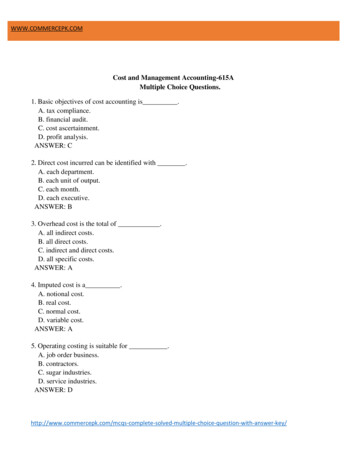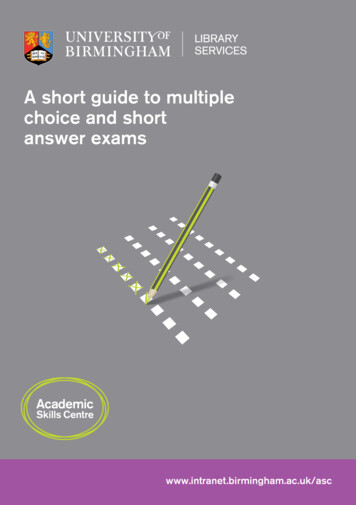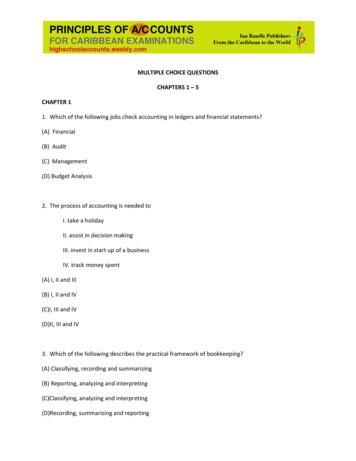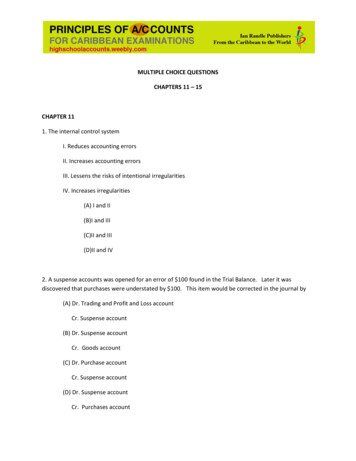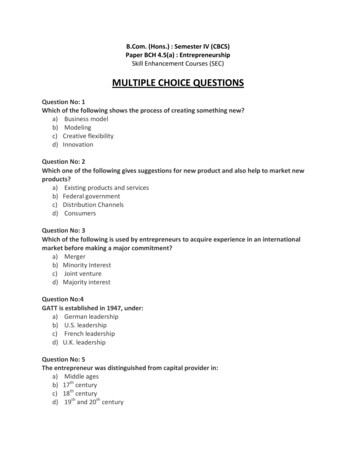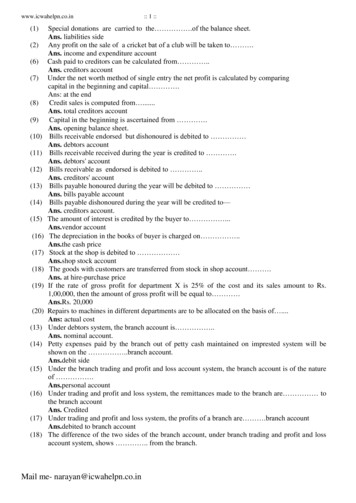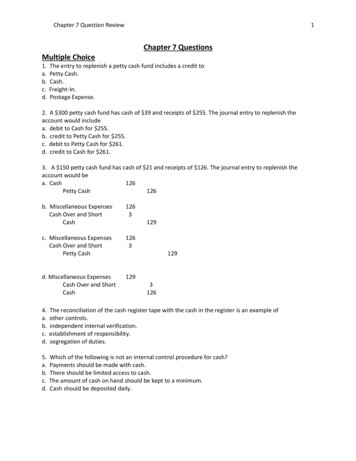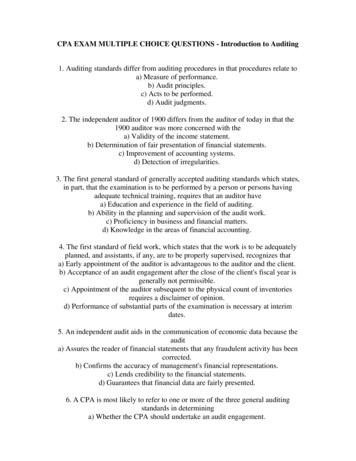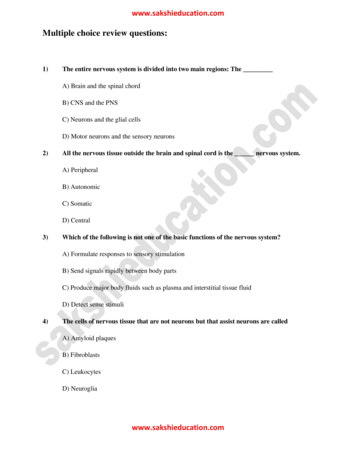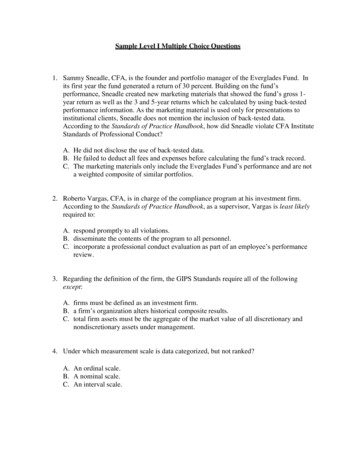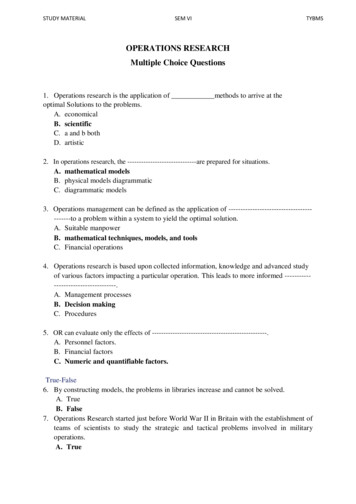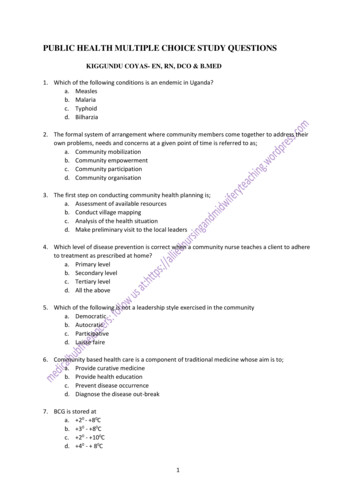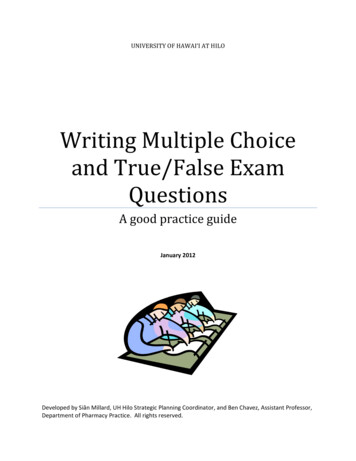
Transcription
UNIVERSITY OF HAWAI‘I AT HILOWriting Multiple Choiceand True/False ExamQuestionsA good practice guideJanuary 2012Developed by Siân Millard, UH Hilo Strategic Planning Coordinator, and Ben Chavez, Assistant Professor,Department of Pharmacy Practice. All rights reserved.
Contents1.Overview and Guide Objectives . 32.Purpose of Exams . 33.Characteristics of Exams . 34.Types of Exam Questions . 45.Blooms Taxonomy of Cognitive Levels: An Overview . 46.Multiple Choice Questions .5Structure of Multiple Choice Questions. 5Strengths and Weaknesses of Multiple Choice Questions . 6Developing Multiple Choice Questions . 6Other Tips on Developing Response Options . 8K-Type Questions . 97.True/False Questions . 9Types of True/False Questions. 9Strengths and Weaknesses of True/False Questions .10Developing True/False Questions.118.Blooms Taxonomy of Cognitive Levels: Question Examples .11Tips for developing ‘higher-order’ MCQ’s .139.Pulling Everything Together: The Exam as a Whole .1410.Evaluating Exam Questions.1411.References .1612.Further Reading .16Annex I: Further Examples of ‘Higher Order’ MCQ’s .172
Writing Multiple Choice and True/False Exam Questions:A Good Practice Guide1. OVERVIEW AND GUIDE OBJECTIVESIn this guide you will learn how to apply the art of question design to the development of effectivemultiple choice and true/false questions for exams that you set.Specifically, this guide is designed to help you to: Understand the key purpose and characteristics of effective exams Understand the main types of open and closed exam questions and what they can be usedfor Understand the levels of Bloom’s Taxonomy of Cognitive Levels and its application to examquestion design Understand the structure and strengths and weaknesses of multiple choice and true/falsequestions Design effective multiple choice and true/false questions Present your overall exam in a clear and consistent format Evaluate the effectiveness of your exam questions and identify student learning needs fromexam responses2. PURPOSE OF EXAMSThe main purpose of exams is to test students’ understanding of what has been taught in line withlearning objectives. In that way, teachers can assess which students are performing well, which mayrequire additional support, and which areas of study students are particularly struggling to grasp.To design an exam you need to be very clear about what you want to test, and then write questionsto meet that objective.3. CHARACTERISTICS OF EXAMSThere are four key characteristics of effective exams. They need to be:i.Valid The exam tests what you intend it to test It is consistent with the course/learning objectivesii. Reliable Allows consistent measurement of student performance3
Discriminates between different levels of performance (i.e. you can determine from theexam results which students are doing well and which not so well in your class)iii. Recognizable It is representative of what you taught in the class (i.e. it does not include anything that youhave not mentioned in class or referred students to in homework)iv. Realistic It is designed so that it can be completed in the time available4. TYPES OF EXAM QUESTIONSThere are four main types of questions commonly used in exams:i.Short answerii. EssayOpen questionsiii. Multiple choice questions (MCQ’s)iv. True/false questions (strictly speaking these are a sub-type of MCQ’s)Closed questionsShort answer and essay questions invite an open response from students. They are commonly usedto assess critical thinking and logical reasoning by inviting students to analyze, synthesize andevaluate. They challenge students to create rather than select a response. They however tend to berestricted to assessing a limited sample of the range of content from a course, and can be difficultand time consuming to grade consistently.The focus of this guide is on the design of multiple choice and true/false questions. Thesequestions invite students to select from a list of potential options, within which is the correctanswer. There is a misconception that these types of questions are ‘easy’ and only test knowledge orcomprehension rather than other higher forms of cognitive skills.5. BLOOMS TAXONOMY OF COGNITIVE LEVELS: AN OVERVIEWBenjamin Bloom created a Taxonomy of Cognitive Levels in 1956. The Taxonomy is a multi-tieredmodel of classifying thinking according to six levels. It provides a useful structure in which tocategorize exam questions:o Knowledgeo ComprehensionLower levelo Applicationo Analysiso SynthesisUpper levelo EvaluationThe taxonomy is hierarchical – the first three (knowledge, comprehension and application) indicate‘lower’ cognitive levels, and the last three (analysis, synthesis and evaluation) indicate ‘higher’4
cognitive levels. The taxonomy can also be identified by what level of education each step typicallycovers (see illustration below):Multiple choice questions can be designed to test almost all of these different cognitive levels (apartfrom synthesis, see section 8). The type of question you ask will determine what cognitive level youtest. Examples of different types of multiple choice and true/false questions by cognitive level aregiven in section 8.6. MULTIPLE CHOICE QUESTIONSStructure of Multiple Choice QuestionsA multiple choice question (MCQ) has two core components – the stem and the response options.There are two types of response options – the key (correct option) and the distracters (incorrectoptions):Drinking during which trimester is associated with the greatest risk of fetal alcoholsyndrome?Stem – poses the statement or questiona) First*Key – correct response optionb) Secondc) ThirdDistracters – incorrect response optionsd) There is no risk5
Stems can be written as a question or an incomplete statement which the response options thencomplete. In MCQ’s there is typically only one correct response option out of a possible three tofive. Research has shown that three-option items are as effective as four-choice options (seeMcKeachie (1986)), though note that students will have a greater probability of guessing thecorrect answer with three rather than four-options. Using more than five options makes it moredifficult to come up with plausible distracters and it increases the reading load on students.Strengths and Weaknesses of Multiple Choice QuestionsMCQ StrengthsVersatility in measuring different levels ofcognitive skillsPermit a wide sampling of content and learningobjectivesMCQ WeaknessesCan be difficult and time-consuming toconstruct properlyEase of writing low-level knowledge items leadseducators to neglect writing items to test higherlevel thinkingProvide highly reliable test scores (objective)Scores can be influenced by reading abilityCan be accurately and quickly scored (either by Can be difficult to find plausible distractershand or by machine reader)Incorrect choices point to student learning needs Does not measure writing abilityReduced guessing factor compared with May encouragetrue/false items (because tends to be four true/false)response options rather than just two)guessing(butlessthanDeveloping Multiple Choice QuestionsMCQ’s should be developed and based on an educational or learning objective of the course. Thetables below provide some tips on writing ‘good’ stems and response options, with examples whereappropriate.Examples (correct responses are starred* where relevant)Tips on developing STEMSNot so good stemBetter stemWrite items precisely, clearly, and assimply as possibleSuppose you are a mathematicsprofessor who wants to determinewhether or not your teaching of aunit on probability has had asignificant effect on your students.You decide to analyze their scoresfrom a test they took before theinstruction and their scores fromanother exam taken after theinstruction. Which of thefollowing t-tests is appropriate touse in this situation?a) Dependent samples*b) Heterogenous samplesWhen analyzing your students’pretest and posttest scores todetermine if your teaching has hada significant effect, an appropriatestatistic to use is the t-test for:a) Dependent samples*b) Heterogenous samplesc) Homogenous samplesd) Independent samples don’t be too wordy don’t include irrelevantinformation6
Examples (correct responses are starred* where relevant)Tips on developing STEMSBe aware of cultural or languagebiases e.g. avoid colloquialphrases or terms that could bedifficult for someone tounderstand where English istheir second languageAvoid the use of negatives – orhighlight them if you do –because they can be easilyoverlooked when readingEnsure consistent grammar fromthe stem to all response optionsNot so good stemBetter stemc) Homogenous samplesd) Independent samplesTypically how old are keiki whenthey start elementary school?a) 3 years oldb) 4 years oldc) 5 years oldd) 6 years oldTypically how old are childrenwhen they start elementary school?a) 3 years oldb) 4 years oldc) 5 years oldd) 6 years old‘Keiki’ is a Hawaiian term for children– literal translation meaning ‘littleone’. Not all students, especially iffrom out-of-state or international,may know this term.Which of the following is not arequired element forphotosynthesis to occur?a) Carbon dioxideb) Oxygen*c) Sunlightd) WaterAlbert Einstein was a:a) Anthropologistb) Astronomerc) Chemistd) MathematicianWhich of the following is NOT arequired element forphotosynthesis to occur?a) Carbon dioxideb) Oxygen*c) Sunlightd) WaterWho was Albert Einstein?a) An anthropologistb) An astronomerc) A chemistd) A mathematicianExamples (correct responses are starred* where relevant)Tipsondeveloping Not so good responseBetter response optionsRESPONSE OPTIONSoptionsKeep a similar length for all The term operant conditioningrefers to the learning situation inresponse optionswhich: Common mistake to write a) A familiar response is associatedwith a new stimulusthe correct option withb) Individual associations are linkedmore elaboration or detailc)d)together in sequenceA response of the learner isinstrumental in leading to asubsequent reinforcing event*Verbal responses are made toverbal stimuliThe term operant conditioningrefers to the learning situation inwhich:a) A familiar response is associatedwith a new stimulusb) Individual associations are linkedtogether in sequencec) The learner’s response leads toreinforcement*d) Verbal responses are made toverbal stimuli7
Examples (correct responses are starred* where relevant)Tipsondeveloping Not so good responseBetter response optionsRESPONSE OPTIONSoptionsEnsure distracters are plausibleEnsure response options are mutuallyexclusiveReduce reading load by movingwords into the stem wherepossible.Make sure there is only onecorrect or best response, or makeclear that you are looking forthe best answer (in which caseall of the response optionscould be correct but one ofthem is the best).Who was President of the UnitedStates during the War of 1812?a) Abraham Lincolnb) John F Kennedyc) James Madison*d) Richard NixonWhat is the average effectiveradiation dose from a chest CTscan?a) 1-8 mSb) 8-16 mSvc) 16-24 mSvd) 24-32 mSvSociobiology can be defined as:a) the scientific study of humansand their environmentb) the scientific study of animalsocieties and communication.c) the scientific study of etc .The function of the hypothesis in aresearch study is to provide a:a) tentative explanation ofphenomenab) proven explanation ofphenomenac) framework for interpretation ofthe findingsd) direction for the researchWho was President of the UnitedStates during the War of 1812?a) Thomas Jeffersonb) James Monroec) James Madison*d) John Quincy AdamsWhat is the average effectiveradiation dose from a chest CTscan?a) 1-7 mSv*b) 8-15 mSvc) 16-24 mSvd) 25-32 mSvSociobiology can be defined as thescientific study of:a) humansandtheirenvironmentb) animalsocietiesandcommunicationc) etc .According to the [lecture/authoretc], the most important functionof the hypothesis in a researchstudy is to provide a:a) tentative explanation ofphenomenab) proven explanation ofphenomenac) framework for interpretation ofthe findingsd) direction for the researchOther Tips on Developing Response Options Use common er
3 Writing Multiple Choice and True/False Exam Questions: A Good Practice Guide 1. OVERVIEW AND GUIDE OBJECTIVES In this guide you will learn how to apply the art of question design to the development of effective
